The hormone is a physiologic organic chemical substance produced and secreted by endocrine glands that pass into the circulatory system for transport. Hormones inhibit, stimulate or regulate the functional activity or target organ or tissue. However, organs like the uterus and hypothalamus produce hormones that do not meet the classic definition. Reproductive hormones are highly specific and selective in their action on the genetically conditioned target organs, and hormones are squired in different amounts in different species to produce a specific effect.
Reproductive Hormones of Horses
There are as many as 17 hormones are directly involved with equine reproduction. The hormones have been produced in the hypothalamus, pituitary gland, and gonads. The hormones are not species-specific in their action, as the estrogen hormone of women or mares, when injected into a cow, produces the same effect as the cow’s estrogen.
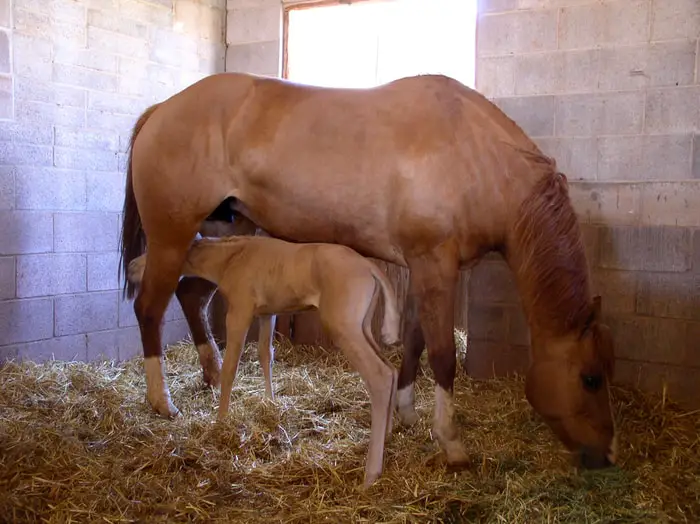
Classification of Hormones of Horses
Hormones may be classified according to their mode of action and chemical properties. You may find many other classifications, but the most common types of reproductive hormones are classified as such.
Mode of Action of Hormones
1. Primary Reproductive Hormones.
These regulate various reproductive processes such as spermatogenesis, ovulation, fertilization, implantation, maintenance of pregnancy, foaling, estrus cycle, heat detection, and parturition.
2. Secondary or Metabolic Hormones.
These indirectly influence reproduction and are responsible for the general well-being, metabolic state, and growth of animals which permit the full effect of primary reproductive hormones.
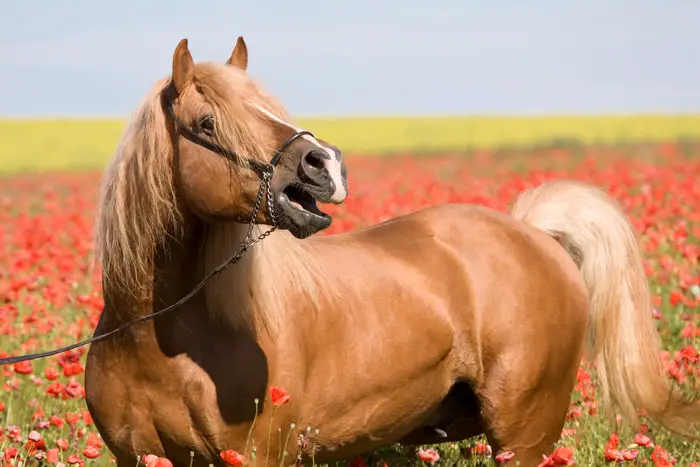
Chemical Structure of Hormones
Based on Chemical Structure, Hormones May be Classified into 3 Groups.
1. Proteins Hormones
These are polypeptide and glycoprotein in nature, having a molecular weight of 300-7000 daltons. Since enzymes quickly digest them, they cannot be given orally and must be administered by injections only, e.g., FSH, LH, oxytocin, insulin, prolactin, TSH, HCG, relaxin, etc.
2. Steroid Hormones
These have a molecular weight of approximately 300-400 daltons. Natural steroids are not effective by oral administration, but synthetic or plant steroids can be administered both orally and parenterally, e.g., estrogen, progesterone, and aldosterone.
3. Fatty Acid Hormones
These have a molecular weight of approximately 400 daltons and can be administered by injection only since they are digested orally, e.g., epinephrine, norepinephrine, thyroxin, etc.
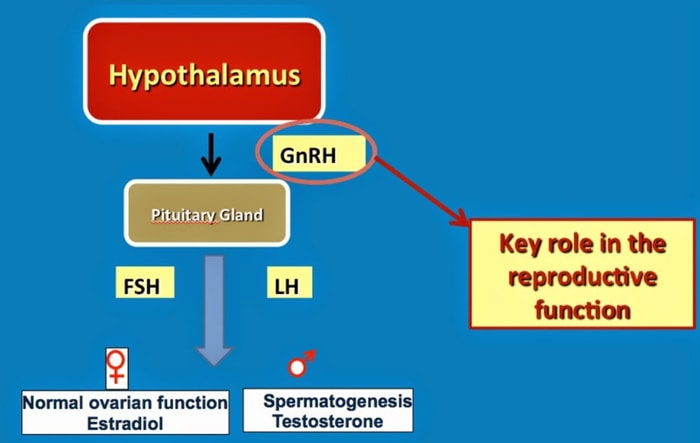
Functions of Reproductive Hormones of Horses
There are as many as 17 hormones directly involved with the reproductive activities of stallions and mares. There are hundreds of other hormones that are involved indirectly with the reproductive activities of horses. The hormones of reproduction are categorized into the following groups basing on their site of production.
A. Hormones Secreted by Hypothalamus
Hypothalamus is an essential part of the hindbrain. The hypothalamus has many functions to maintain growth, balance, and reproduction by secreting hormones. The hypothalamus secretes the following reproductive hormones:
1. GnRH (Gonadotropin-Releasing Hormone). It is a decapeptide hormone with a molecular weight of 1183 daltons. This hormone induces the release of both FSH and LH from the anterior pituitary.
2. GHRH (Growth Hormone Releasing Hormone). It stimulates the release of growth hormones.
3. GHIH (Gonadotrophin Hormone Inhibiting Hormones) or Somatostatin. It inhibits the release of growth hormones.
4. TRH (Thyroxin Releasing Hormone). It stimulates the release of thyroid-stimulating hormones and prolactin.
5. PIH (Prolactin Inhibiting Hormone). Inhibits release of prolactin.
6. CRH (Corticotropin-Releasing Hormone). It stimulates the release of ACTH.
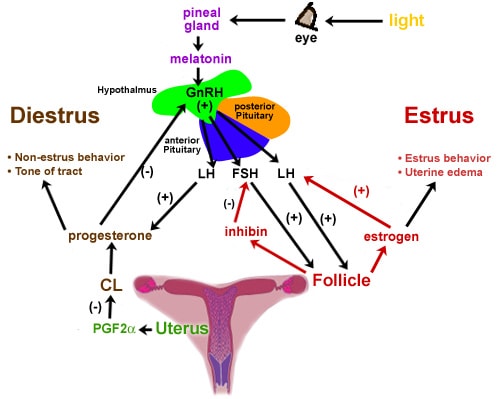
B. Hormones Released from Anterior Pituitary Gland
The hormones of the anterior pituitary that act on the gonads are collectively called gonadotropins. The gonadotropins stimulate Gonads in both stallion and mare. There are mainly three gonadotropin hormones:
7. FSH (Follicle-stimulating hormone). FSH stimulates the growth and development of ovarian follicles and the production of estrogen from growing follicles.
8. LH (Luteinizing hormone) This hormone is responsible for the ovulation and transformation of granulosa cells of rupture follicle to CL. The presence of LH is necessary for the maintenance of CL and secretion of progesterone. LH acts in conjunction with FSH to induce estrogen secretion from the developing follicles. In stallion, it is called ICSH, and androgens are produced only after LH stimulation.
9. Prolactin Hormone. The reproductive functions of prolactin are to stimulate CL function and progesterone secretion, and It acts on CNS to induce maternal behavior. One other imp function of prolactin is that it promotes lactation. It has also been shown to have luteotrophic properties in various species (rodents) though, in domestic animals, luteotrophic properties are not established as the primary luteotrophic hormone is LH.
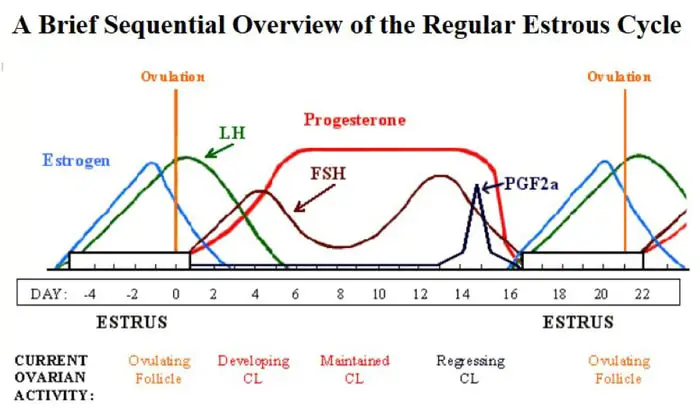
C. Reproductive Hormones Produced By Posterior Pituitary
The hormones that are secreted by the posterior pituitary gland of the brain are directly involved with horse reproductive activities are:
10. Oxytocin Hormone. Oxytocin is synthesized in the supraoptic nuclei of the hypothalamus and is stored and released from the posterior pituitary. Estrogen enhances the effectiveness of smooth muscles to oxytocin. The ovary also produces oxytocin. The main functions of oxytocin are:
- Stimulates uterine contraction.
- Transport of both male and female gametes in the oviduct.
- Milk let down or milk ejection. The lactating female becomes conditioned with visual and tactile stimuli associated with suckling and milking.
- This condition induces the release of oxytocin into circulation to act on cells that surround alveoli in the mammary gland resulting in milk let down.
D. Gonadal Steroid Hormones of Reproduction
11. Estrogen Hormone. The most common estrogenic substance is estradiol, and the other two estrogens are estrone and estriol. Estrogen is produced from the ovary under the influence of LH & FSH. The main functions of estrogen are:
- It promotes sexual behavior.
- Stimulates secondary sexual characteristics.
- Stimulates growth of tubular genitalia, in particular, the growth of uterine endometrium and myometrium,
- Growth of the mammary gland.
- Induces uterine contractions during estrus.
- Controls release of gonadotropin hormones through a feedback mechanism.
- Also, it stimulates Calcium uptake in bones and has anabolic effects.
12. Progesterone Hormone. They are secreted by luteal cells of the Corpus Luteum (CL) and by the placenta. LH primarily stimulates secretion. In cows, the amount of progesterone secreted by the placenta is minimal, and hence the presence of CL is necessary until late in pregnancy. The main functions are:
- Inhibits uterine contractions.
- High levels of progesterone inhibit estrus and the ovulatory surge of LH.
- Stimulates the endometrial gland to secrete an endometrial fluid necessary for the nourishment of blastocyst before implantation.
13. Testosterone Hormone. The testosterone hormone is produced by the Leydig cell of the testis. The hormone is responsible for developing reproductive organs, behavior, and manifestations of signs of maturity in stallions.
14. Relaxin Hormone. Mainly secreted by the uterus, also known to be secreted from CL and placenta. It causes dilation of the cervix and vagina before parturition.
15. PMSG (Pregnant Mare Serum Gonadotropins). A glycoprotein hormone secreted by uterine endometrium during 40-140 days of pregnancy in mares. PMSG has both FSH-like and LH-like activity, but predominately it has FSH-like action. Secretion of PMSG stimulates the development of ovarian follicles, some of which ovulate and develop into accessory CL which produces progesterone. PMSG is also used clinically to induce superovulation.
16. HCG (Human Chorionic Gonadotropins). Glycoprotein hormone is present in the urine of pregnant women. It can be detected in urine eight days after conception by RIA (Radio Immune assay). It has mainly LH-like action and little FSH activity. It can be used for induction of ovulation and to treat cystic ovaries.
17. Placental Lactogens. Placental lactogens have been found in several species. These hormones are protein in nature with properties similar to growth hormone and prolactin. It is more imp for its growth properties than for prolactin properties. Placenta lactogen is imp in regulating maternal metabolism to ensure the availability of adequate nutrients to developing fetuses.
Secondary Hormones Hormones of Reproduction
These hormones are not directly involved with the reproductive activities of the stallion and mare. Their actions help in the growth and development of organs, systems, and associated activities. The hormones are:
- Somatotropin Hormone (STH). Somatotrophin/growth hormone is responsible for the growth of the body.
- Thyroid Stimulating Hormone (TSH). Thyroid-stimulating Hormone stimulates thyroid function.
- Adrenocorticotropic Hormone (ACTH). Adreno corticotropic hormone is responsible for stimulating the adrenal cortex.
- Antidiuretic Hormone (ADH) or Vasopressin maintains a water balance.
- Thyroid Hormone. Thyroxin-body growth, development and maturation, and oxidation of feeds.
- Parathyroid Hormone. Paratharmone-Ca and P metabolism.
- Calcitonin Hormone. Opposite to parathormone.
- Adrenal Cortex. Aldosterone is responsible for electrolyte, water balance within the body.
- Cortisone. Responsible for carbohydrate fat and protein metabolism.
- Insulin. Responsible for carbohydrate, protein, and fat metabolism.
- Glucagon. It has got reverse action of insulin.
Concluding Remarks on Reproductive Hormones of Horse
Successful horse reproduction is the key to a breeding farm of horses. Horse reproduction is a systemic and scientific process. Many reproductive hormones are involved in this process. As a horse owner or veterinarian, you must have prior knowledge of hormones involved in equine reproduction. In my article, I have briefly highlighted the hormones of equine reproduction.